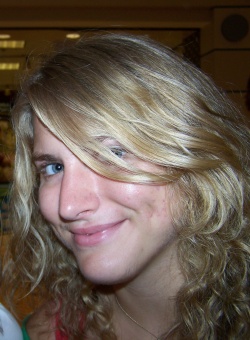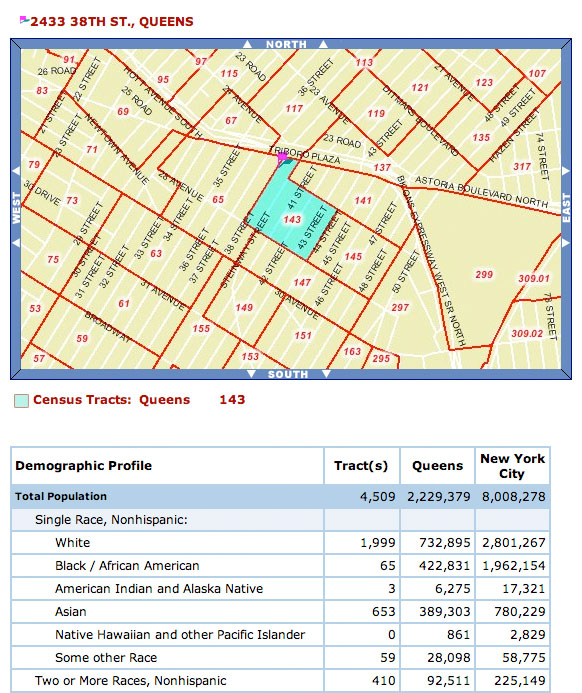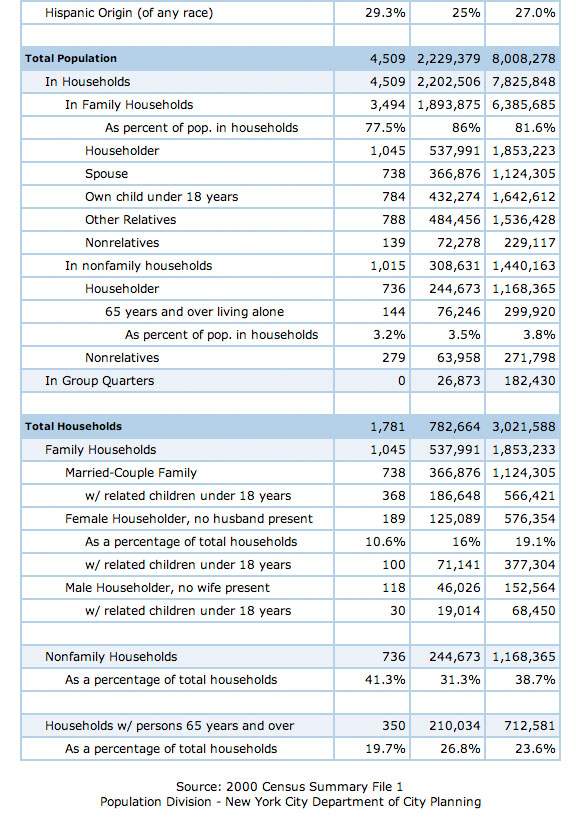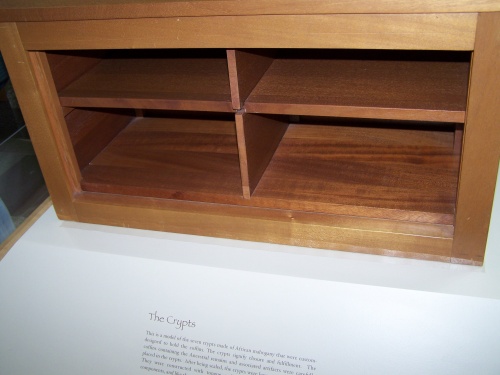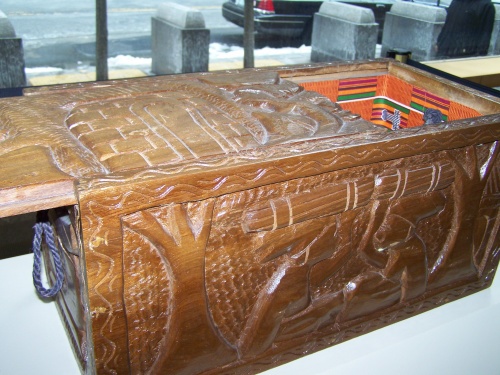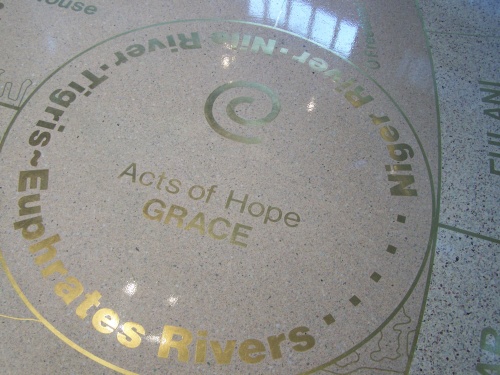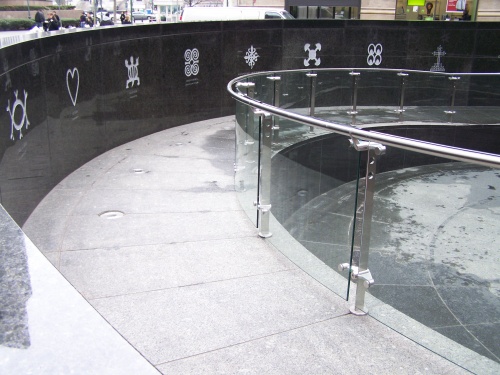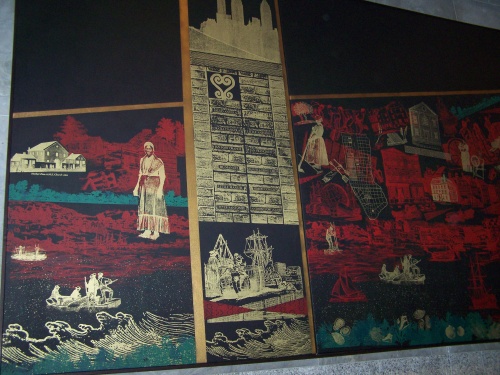From The Peopling of New York City
Contents |
About Me
My name is Emily Musgrove. I am nineteen years old. I grew up in Northern Virginia, close to Washington, D.C. I like to spend time with my friends. That is my favorite thing to do in the world. I also enjoy eating both free food and all the food that I can afford to buy. There’s something about the necessity of food that brings people together. I like to be outside and I like to walk around different parts of the city. I love photography, but I don’t carry my camera around often enough because I can be pretty lazy. I like to visit my friends all over and I also love to meet new people. I want to start swimming again, like I did in high school, but I am out of shape. I don’t like sitting still for long periods of time and I am not a morning person. I love my iPod Classic. It is one of the best Christmas presents I have ever received. I am very impatient, especially when I am on the train in the morning. Listening to music helps calms my nerves and it has always been a form of escape for me. That’s all the bio I have for you right now. Hopefully you’ll learn a lot more as you get to know me!
Ideal Community
In my dream world, a type of ideal society can only be imagined. It would consist of the combined beauties of architecture, industry, and natural wonders. The transportation system would be efficient, convenient, and universally obtainable. Buildings and transit systems would be beautified with murals and geometric, yet functional metal infrastructures. The strength of this community would be composed of the people. They would value rational thought, analyzing beliefs and knowledge in each their own way. However, hope for something else more significant would be encouraged. Many parks with flowing waterways, beaches, waterfalls, woods, flowers, creatures, and other natural wonders would enhance these notions of a higher order of things. Intricacies of life, nature, and industry would be admired and appreciated for their rightful places.
Through fellowship and optional studies, everyone would be encouraged to be courageous enough to have faith in something higher than themselves, not just in an omniscient power, but also in the community of people as a whole. People would be diverse in their backgrounds and all cultures and faiths must be embraced. Prejudice and preconceived notions would be prohibited. Tolerance, respect, and compassion are to be expected. Music of many types would be allowed and all of the fine and performing arts would be seen as valuable forms of expression. The most important values would consist of exploring one’s self and their surroundings, communicating, and socializing.
Immigration Flip Clip
From There to Here
My mother went to high school in Nyack, New York, while her father worked in the city. Their family, the Van Wycks, have a lot of history in New York. There is the Van Wyck Expressway, and even a Van Wyck Homestead Museum in Fishkill, NY. However, I have only been there once, and have learned little of their history. They are of Dutch descent, but came over to America in the 1600's. My grandmother on my mother's side can only trace her ancestry back to the hills of Tennessee. She currently lives with my grandfather in a suburb of Nashville. She is part Native American, as well as part European and my Grandfather is a mix of mostly Dutch and German.
My father's heritage is even harder to trace than my mother's. His father grew up in Georgia under great poverty. My grandfather never knew his father and his birth certificate is so inaccurate that it mistakenly says he is a female. It is said that my Great, Great, Great, Great, Great, Grandmother was an Indian Princess of the Creeks. She had her name changed from Cousaponakeesa to Mary Musgrove after she married John Musgrove from South Carolina. After researching them, I am still unsure whether she had any children by John Musgrove. My grandmother grew up in Washington, D.C. Her last name is Hall and she is part English, as was my grandfather. When I used to ask her questions about her family and her heritage, she would tell me that since her family is from Washington, D.C., she had ancestors fighting for both sides of the Civil War, which was truly "Brother against brother." She also told me many of the family documents and ways to trace heritage were lost during the flu epidemic in the early 1900's. She grew up during the Great Depression. My grandfather enlisted in the Navy and fought in WWII. If it wasn't for that, he would have never met my grandmother at a vaction spot in Colonial Beach, Virginia. With the help of the G.I. Bill, they settled and started a family in Southeast, D.C., where my father was born. When my father was 8, and living with four brothers and a dog, seven people total, his family moved from their two bedroom triplex to a place close to Southeast D.C. in Oxon Hill, Maryland called Friendly. He grew up during the Civil Right's Movement and witnessed the riots. His parents had to show papers to enter D.C. to work and the skyline glowed orange from all of the fires.
My dad went to college in a Naval ROTC program and he followed his father's footsteps to join the Navy. My mother was a government employee living in Northern Virginia, and they met through a mutual friend. My parents settled down in Centreville, Virginia, close to Washington D.C. There, they had my older sister Lynn. Before they had my twin brother and I, however, they moved to Woodbridge, Virginia, less than 30 miles away from D.C. Woodbridge is where I attended elementary, middle, and high school. As a junior in high school, after visiting NYC a few times, and thinking about my future, I decided that I wanted to go to college in New York City. My parents did not want me to go to school in the city, however, and my Dad simply told me he would sign my student loans. I did my research and I decided that Baruch was the place for me. I applied for Macaulay Honors Program, and here I am today.
I came in August for orientation, without a home yet. My parents wanted me to sign up for an organization called Educational Housing Services, which has housing for students and interns throughout New York City. They did not feel it safe for me to find an apartment yet since I knew few people in the city. The housing I chose was in Manhattan on the Eastside, in a YMCA. The move-in day was August 30th, but classes and orientation began weeks before that. For two weeks, I stayed either with friends in New Jersey or my Aunt in Upstate New York, commuting place to place with a large suitcase and my backpack.
Living in student housing was a very interesting experience, but it was not worth the cost, so I decided to move out by the end of my first semester. I met a lot of people but I do not feel like I am missing out on anything not still living a dorm-type enviroment. I found someone with an apartment in Williamsburg, Brooklyn, who was looking for a roommate. I was running out of options and I decided to move in with her in December. By February, I realized that she was on drugs, slightly crazy and overcharging me. That is when I decided to move in with another Baruch student who was looking for a roommate. We have many mutual friends and we live in Astoria, Queens. I am comfortable there and am going to stay there this summer for my summer class and my internship.
From what I know, I am part Dutch, German, English, and Native American. Everything else is somewhat a mystery. I cannot tell you the percentages of anything. My from there to here story is not one of immigration but of migration. Still, it reflects the immigrant experience because I have been through hardships on my search for my American Dream.
Neighborhood Census Tract
Astoria is a fairly quiet neighborhood. I live only a block away from Steinway Street, where there is Middle Eastern culture seen throughout the different restaurants, stores, and Hookah Cafes. I also live a short walk away from 30th Avenue, where there are marketplaces, a large grocery store, and many cafes. It is also a privilege to be able to walk to Astoria Park. A deli is only two doors away and the laundromat is across the street. I have everything I could need in my reach.
Class Notes
Presentation week after next. Last Class Meeting at Krase’s house? Date of final. Last day of submission of all work- end of finals No class on the 15th
REPRESENTATIONS
IM/MIGRANTS
IMAGES-PHOTOS still images, moving images
Sample surveys
Whole material – selecting
Field trips
There to here essays
Books
Census data
Mapping
March 27, 2009 -PoTs Ethic Succession -Theory -Ideologies
Journalism Social Sciences - history - sociology - political science
^ entertainment v
> accessibility = need large audience, simulate
v accuracy, realiability , validity^ -less important in media, more important in social science, smaller, more focused audience
Simulations in class- field trips, movie clips
science- is ideology- ought to be
Comparisions - groups - theories - authors
Beyond the Melting Pot -Ethic Succession 1920’s -70’s
Foner- Women
It’s magical, not magic. –Prof. Krase on DVD
Bus is a metaphor for Brooklyn – diversity, cooperation in order to get point A to point B
Cultural Pluralism Multiculturalism Assimilation (accommodation)
pick questions… 1 hr b4 class, collaborative class hour before, answer class questions.34
March 20: Puerto Ricans – more politically powerful, here since 1920’s, challenged by other new immigrant groups Belmont “Little Italy” 8-9% Italian, predominantly Hispanic
— Melting Pot : — Assimilation-culture, structure— dissolve, become part of solution, being a part of American society (anglo-conformity)
Stew Pot- Cultural Pluralism, keep culture and become American at the same time, accommodation ****most likely to occur
Salad Bowl- Multi-culturalism- Retain culture and don’t change!
Acculturation, and accommodation
Moving up the ladder Acculturation
Jan 30
Joseph Berger- The World in a city
Nancy Fona- Ellis Island to JFK
Glazer and M Beyond the Melting Pot Suffolk Community in the city by Krase www.brooklynsoc.org
Assignments: 1. bio- personal and photo 2. Ideal Community 50 words (exists or fictional) –visually oriented(what would it look like) –email all assignments as attachments
Userlist > portfolio- email 2 him 4 preliminary syllabus
Field Trip Notes
Ellis Island
In 1990, Ellis Island was restored and opened as a museum. However, it opened in 1892 and processed over 12 million immigrants up until 1954. It was where immigrants came looking for a chance at the American Dream, whether to avoid oppression or to pursue economic opportunity. The ferry ride out to Ellis Island is beautiful, and you can see the Statue of Liberty from the Island. At the museum, it brings your imagination to a whole new level, to know that immigrant related to you once came through the harbor and saw a symbol of freedom like the Statue of Liberty on the way to America, the Land of Opportunities.
Tenement Museum
97 Orchard St.
We were led on a guided tour of the Moore Family's life in America.
It was very interactive, with music clips, even at a remake of a wake, which had sad background music playing. We learned about the customs of an Irish Catholic funeral, with the death of a Moore child in 1869. Walking through the authentic tenement, we saw life as it was for the Moores while we learned of the horrific conditions they faced in their search for the American Dream. Sickness, death, birth, and life. We learned of the hardships immigrants faced while living in the tenements, and we saw how their lives were enriched by music, ritual, and family.
Example of Irish Music, used on Main Page of Wiki:
African Burial Ground
The African Burial Ground is easy to be missed, seeing as how it is in downtown Manhattan, amongst many office buildings, not far from City Hall. I was surprised to reach the intersection of Duane St. and Elk St., where my friend's mother works. I had no idea that inside the building was also a museum, and in the backyard was a majestic memorial. The video we watched was very informative and the tour guide had a wealth of information about the African History intertwined with the memorial. The symbols on the memorial were beautiful and full of meaning. We got information on which each one of them meant, as well as where they were descended from. There were a lot of different dialects and cultures that came together at the Memorial, from all over different regions of Africa. There was a vast mural that told the story of slavery and the African people who migrated to American and were forced to make a life for themselves in a foreign place, against their will. We got to understand the pain and the customs of the African people through learning about the Burial Ground.
Midterm
1) There are three main ways in which immigrants may adjust into American society. They are assimilation, multiculturalism, and cultural pluralism, cultural pluralism being the most common. Cultural pluralism consists of immigrants keeping their own culture and becoming American at the same time. Multiculturalism is similar in that immigrants retain their own culture, but they do not change to become more American. Assimilation is when immigrants do not retain their homeland’s culture at all and instead conform completely into America’s culture. Assimilation can be seen as the most drastic change immigrants can make when they come to the United States. It means that an immigrant’s own culture dissolves and they become completely American. However, in my opinion, being American does not mean you cannot maintain another culture at the same time.
It has been said that America, and New York City in particular, can be seen as a melting pot, but there are several reasons why that metaphor lacks accuracy. To some, American society is seen as a community based on Anglo-conformity. On the contrary, today, immigrants of many different cultures and ethnicities inhabit the US and New York City. Even in the 1960’s, when Beyond the Melting Pot was written, Nathan Glazer and Daniel Moynihan recognized that New York City could not resemble a melting pot if the five main ethnic groups of New York City lived in such distinct ways apart from one another. Not only are there few customs and values that all Americans follow across the board, a melting pot would imply that all the ingredients have lost their unique attributes and have melded into one substance indistinguishable from the specific ingredients themselves. In turn, assimilation and the melting pot theory have little legitimacy when it comes to immigration in New York City.
The opposite of a melting pot would be a salad bowl, where each ingredient does not change at all, but instead, each vegetable and ingredient maintains its own individual flavor. The idea of a salad bowl is used in illustrating multiculturalism. If an immigrant keeps its own culture intact without becoming more American, they do not lose any of the distinctiveness that is involved in retaining their own culture. Although this theory may seem more applicable to immigrants than the melting pot theory, it is uncommon that an immigrant does not develop any sense of Americanism whatsoever. When people immigrate to the US, although specific cultural enclaves make it easier to maintain one’s culture, it is difficult not to be affected at all by the greater extent of one’s surroundings. This is why cultural pluralism is the most common form of acculturation used by immigrants in New York City.
Cultural pluralism is the least extreme ideology of how immigrants adjust to American society. It involves accommodation by assimilating some American customs while still retaining aspects of one’s original culture. This combination of multiple cultures into one is the most common because it is perhaps the easiest way of adjusting to American society. It is compared to a stew pot where each ingredient is distinguishable, yet the main flavor produced in the pot is created by the certain mixture involved in cooking the stew. If one of the cultures is missing, the flavor changes completely, but the nature of the mixture does not.
It seems that most immigrants are combinations of different cultures, and each have their own mix and flavor of combining immigrant and American life. The stew pot metaphor is aptly applied to people of mixed ethnicities and immigrant children growing up with parents of a culture different than that of their own, as well as for the mixture of different people in the US as a whole. Regardless of the culture one’s parent may have, children of either immigrants or parents of varied descent make up a vast majority of New York City’s young people. As a result, the inhabitants of New York City are diverse, yet in this diversity, there is unity. This unity is found in the common bonds of life in America, including hardships, hope, and new experiences. Unity need not imply that everyone is the same; rather, to me it means that diverse individuals are working together to get along.
3) Attaining the status of “whiteness” is not necessarily the threshold for being “American” because one of the greatest aspects about America, and specifically New York City, is its diversity. In many communities, immigrants maintain the culture from their homeland by preserving it through customs, food, and clothing. This is illustrated in the enclaves, or ethnic communities described in the three books we read in class.
In the book The World in a City, New York Times columnist Joseph Berger describes 18 different areas of New York City and how the culture in each area is distinct as well as constantly changing. He also explains how each area is adapting to new and old groups who migrate from one place to another. This has created an ever changing demographic in most areas of New York City. For example, “Little Italy” in Belmont has had it’s population become predominantly Hispanic over the years and is now less than 10 percent Italian. This has not been a rare occurrence in any of the boroughs in New York City.
According to The World in a City, Astoria, Queens has gone from having a heavily Greek population and atmosphere to having more of a Middle Eastern presence. Today, if someone looks down one of Astoria’s most famous streets, Steinway, they can see Moroccan and Egyptian restaurants, people smoking a hookah outside a café here and there, and stores with Middle Eastern foods and sheeshah, flavored tobacco. Astoria is not limited to people from the Middle East and Greece, however. In addition, there are Serbians, Bosnians, Brazilians, and Ecuadorians. There are Delis in which Hispanic food is sold, as well as many different Hispanic Restaurants. Also, there are many young people coming to Astoria, like my roommate and I, for example. Because rent prices are fairly affordable, younger people migrate from Manhattan or other places in the United States to live in Astoria. Many young people also go out to places like Astoria to spend time with friends. I have sat with a group mixed of Asian, Hispanic, and Middle Eastern friends congregating together around a table smoking Hookah and playing cards to pass the time. I have heard white Americans from states other than New York rant and rave about the Greek or Thai restaurants they have visited in Astoria. This type of ethnic and age-based diversity is not only limited to Astoria. It is common throughout the entire city.
The reason why “whiteness” is not the threshold for being American is because many young and old Americans today, especially in New York, can appreciate the diverse atmosphere that is provided throughout New York City and other areas in the U.S. Though it cannot be overlooked that assimilation is inevitable for some immigrants to undergo, the stew pot and salad bowl theories remain much more prevalent in the culture of New York City. This is seen in the wide array of restaurants in the city, as well as in the varied cultural parades, grocery stores, and clothing shops.
Some immigrants become American while retaining their unique customs from their homeland, while others do not adapt to American culture at all. Still, immigrants have their place in American society, and the United States is a country full of immigrants, reaching all the way back to its colonization. Being an immigrant does not make someone any less American. Immigrants from countries and ethnicities everywhere come together to create New York City. Therefore having “whiteness,” or acting like any particular race for that matter, does not determine anyone’s patriotism or status of being American.
==Final==